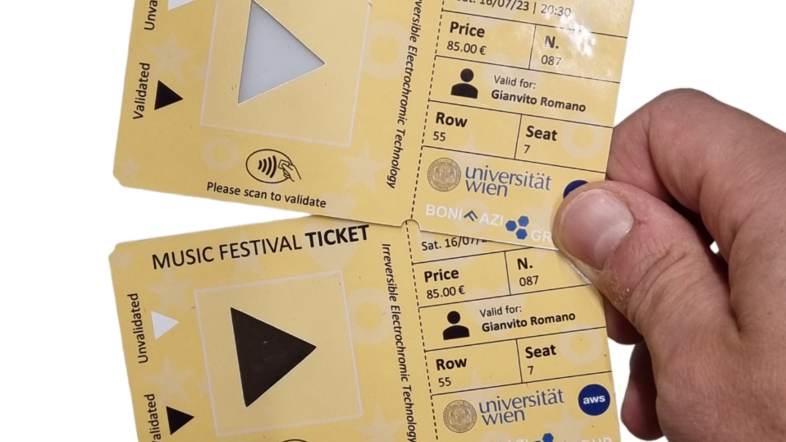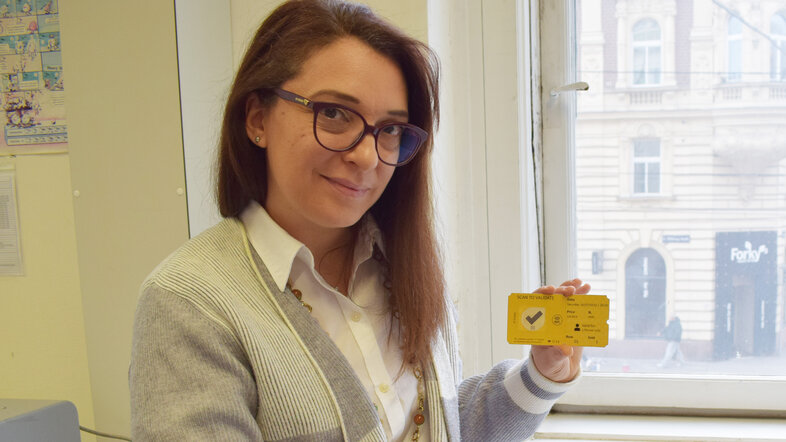A chemical signature of authenticity
Football matches, concerts, clubbing events – the counterfeit market for event tickets is huge, leading to a big economic loss for the industry. With a certain type of electrochromic materials developed by the organic chemist Laura Maggini and her team, such fake tickets could become a thing of the past: "Our smart material is an electrochromic ink, which can be used to print the high-security ticket itself," explains the organic chemist.
Embedded in the ticket are electronic components containing the encoded security and authenticity information. Upon activation and satisfaction of the authenticity requirements, the ink on the ticket will change its colour irreversibly, displaying an authentication that cannot be tampered with. "The security data will thus be stored 'on-edge' on the tickets, instead of on a cloud storage solution where the data could be susceptible to hacking and which requires great amounts of energy to keep safe online – for example, using blockchain technology or data storage", says Maggini: "Yet another reason why we need energy-saving alternatives for high-security tickets and labels, both in the way they are produced and in the way they are used."
We need alternatives for high-security labels that consume less energy, both in the way they are produced and in the way they are used.Laura Maggini
Feel-good hormone going smart
Electrochromic materials include all organic or inorganic materials that are able to change their colour when exposed to an electrical impulse. Laura Maggini has specialised in the field of organic electrochromic materials and is working on the basis of dopamine, a neurotransmitter, which is a messenger between nerve cells. Many may know it as the 'feel-good hormone'. But the fact that the neurotransmitter can also be used to develop new, sustainable electrochromic materials is groundbreaking in the field.
"Most of the organic electrochromic materials available today work in a reversible mode, meaning they can switch colour from one to another, going back and forth many times. This can be useful for certain applications, but would represent a liability for security-related applications, such as tickets," explains Maggini: "For this type of application, we are developing irreversible electrochromic materials based on dopamine. Our materials can switch colour only once and cannot go back in any way. They become a chemical signature of authenticity making counterfeit tickets nearly impossible."
Electrochromic tickets: From the lab to the market
The project "High-security irreversible electrochromic tickets prototype development" led by Laura Maggini and group leader Davide Bonifazi enabled the development of chemically secured high-security tickets. The scientists used the AWS funding to create first demos, integrating the RFID antenna into the screen. Now they are scaling up the material and developing more complex prototypes: The "IrrevoChrom project" is one of eleven recently approved FFG Spin-off Fellowships, led by FFG grant holder Laura Maggini and Davide Bonifazi at the Department of Organic Chemistry at the University of Vienna. Using the FFG fellowship, the researchers are finalising and scaling up the formulation of this innovative water-based, printable, electrochromic ink, which they recently patented (WO 2023180536 A1).
"This fellowship is a unique opportunity because it allows us to really push the technology developed to market readiness level," says Laura Maggini, "We are at the stage of testing our research outside the lab, challenging commercial-grade prototypes in real-life scenarios. Next step: the market." More information about AWS funding for universities (in German) and about the FFG Spin-off Fellowships
Activating the material
In order to be activated and change colour, the organic material needs an electrical impulse, which is why these materials are referred to as ‘electrochromic’. As the chemists want to work as sustainably as possible, they avoid batteries: "We will be using an RFID/NFC antenna – a system that is able to harvest energy from a reader device, comparable to the contactless payment feature of your ATM card. The antenna transfers this energy to the electrochromic ink."
As soon as the printed display on the ticket is activated, it will change colour and show the stored information in a clear, accessible, visual, non-digital way – for example, in the form of a black symbol or a QR code appearing on the previously white background, thus validating the ticket. The ticket can be activated using everyday devices, such as smartphones. You do not need a specific, expensive device for this process. The information will remain displayed without further energy input.
The idea is to develop and use materials that are simple, organic and non-toxic – so we take a sustainable approach.Laura Maggini
Monitoring blood bags
A second research project conducted by Maggini and her collaborators demonstrates how useful and versatile the newly developed, irreversible electrochromic technology can be: Here, they are developing solutions for the health sector, more specifically for the control of blood reserves. These must be stored properly and kept in the best condition. In order to monitor those conditions, especially the temperature, at the scale of the single bag, the researchers are developing a smart label to attach to the blood bag.
By law, blood may be stored for a maximum of 35 days within a specific and stringent temperature range. "Our visual smart labels comprise an irreversible electrochromic display (i-ECD) and will be able to monitor the condition of this important resource: The label is equipped with a temperature sensor, an RFID/NFC system, a battery and the i-ECD. The sensor constantly monitors the temperature and as soon as this parameter moves below or above the permitted temperature range in which the blood should be stored, the sensor will trigger the stimulus to the label. The label will then change colour and showcase a clear message, such as 'Don't use', within a few seconds. The person handling the blood bags will be immediately notified that something is wrong."
Breakthrough in the field of electrochromic materials
Developing electrochromic materials which can change colour irreversibly is a real breakthrough in the field. Many researchers have tried it before but never made it to this point. The foundations of the success of the chemists at the University of Vienna were already laid in the UK by Davide Bonifazi before he and his group, including Laura Maggini, moved to Vienna. "Davide had the idea and brought the inspiration for this research. And of the many different systems we have researched, the most interesting and promising one for the irreversible electrochromic application was dopamine," explains Laura Maggini, "This molecule and neurotransmitter is able to transform into a hybrid polymer changing its colour from white to black. The really big challenge now was to transform this molecule, which is changing its colour by itself, into a system that changes colour at the exact moment we want it to, via an electrical stimulus within a display configuration."
First, the scientists had to identify the right conditions for the molecule to work in a solution in which it would be completely stable, and only then give an impulse to start the transformation. Then, the next challenge was awaiting them: "To go into production and print the ink onto tickets and labels, we cannot work with a solution, we need an electrochromic ink with the consistency of a paste. So, research started again. Within the framework of our FFG Fellowship, we are finalising and scaling up the formulation of this innovative water-based, printable electrochromic ink, which we have recently patented."
A technology with the potential to transform a myriad of industries
"As the initiator of this pioneering research endeavour, I am proud to see its imminent applicability in the market"", says Davide Bonifazi, group leader at the Department of Organic Chemistry: "The sustainable and patented electrochromic materials that our team have developed hold the potential to catalyse transformative changes across a myriad of industries. It is immensely gratifying to witness our fundamental research maturing into practical solutions, offering both sustainable and eco-conscious, high-performance alternatives within the dynamic landscape of modern technology."
Scaling up sustainably
The chemists are currently able to produce about 0.2 kilograms of the organic electrochromic paste per hour – the basis for the irreversible tickets and the technologies for the labels for blood bag monitoring. Their 'shopping list' includes a bigger reactor with which the team around Bonifazi and Maggini will be able to produce up to one kilogram per hour. Producing more in less time is, of course, an aim to ensure that the irreversible electrochromic material becomes an interesting option for the industry.
The system is not only new and groundbreaking but also water-based and consists mainly of organic materials, "We try to consider sustainability at every step," Maggini emphasises. Still, some of the components, such as the chip, are not yet compostable. However, the engineering of the smart labels follows the plug-and-play approach to tackle exactly this issue. It allows users to remove the irreversibly activated display and reuse the electronic components.
The researchers are contributing to global efforts to tackle the growing amount of e-waste produced each year. The aim is to develop fully organic electronic systems made from sustainable materials. "Ultimately, our objective is that electronics become organic", says Laura Maggini: "Ideally, at the end of their life cycle, we would be able to compost our devices." (td)
It is a whole new frontier getting a product out there. This is what is driving me personally as a passion. Finally, we are using all that science we develop to really produce something.Laura Maggini
Maggini obtained her master’s degree in Organic Chemistry at the Sapienza University of Rome (Italy) in 2006. After moving to the University of Namur (Belgium), she first joined the University of Strasbourg (France) and later the University of Cambridge (UK), funded by two consecutive Marie Sklodowska Curie Individual Fellowships.

